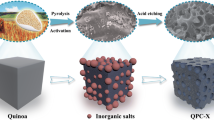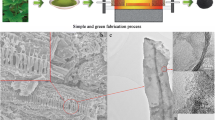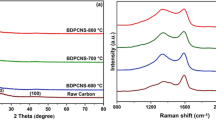Abstract
Energy and environmental are always two major challenges for the sustainable development of the modern human being. For avoiding the serious environmental pollution caused in the fabrication process of porous carbon, a popular energy storage material, we reported a facile, green and activating agent free route hereby directly carbonizing a special biomass, Glebionis coronaria. A nitrogen doped hierarchical porous carbon with a specific surface area of up to 1007 m2 g−1 and a N doping content of up to 2.65 at.% was facilely fabricated by employing the above route. Benefiting from the peculiarly hierarchical porous morphology, enhanced wettability and improved conductivity, the obtained material exhibits superior capacitance performance, which capacitance reaches up to 205 F g−1 under two-electrode configuration, and no capacitance loss is observed after 5000 cycles. Meanwhile, the capacitance retention of the obtained material arrives up to 95.0% even under a high current density of 20 A g−1, illuminating its excellent rate capability. The fabricated nitrogen-doped hierarchical porous carbon with larger capacitance than commercial activated carbon, excellent rate capability and cycle stability is an ideal cost-efficient substitution of commercial activated carbon for supercapacitor application.








Similar content being viewed by others
References
Chu S, Cui Y, Liu N (2016) The path towards sustainable energy. Nat Mater 16:16. https://doi.org/10.1038/NMAT4834
Ma Q, Yu Y, Sindoro M, Fane AG, Wang R, Zhang H (2017) Carbon-based functional materials derived from waste for water remediation and energy storage. Adv Mater 29:1605361. https://doi.org/10.1002/adma.201605361
Wang F, Wu X, Yuan X, Liu Z, Zhang Y, Fu L, Zhu Y, Zhou Q, Wu Y, Huang W (2017) Latest advances in supercapacitors: from new electrode materials to novel device designs. Chem Soc Rev 46:6816. https://doi.org/10.1039/c7cs00205j
Wang C, Wu D, Wang H, Gao Z, Xu F, Jiang K (2018) A green and scalable route to yield porous carbon sheets from biomass for supercapacitors with high capacity. J Mater Chem A. 6:1244. https://doi.org/10.1039/c7ta07579k
Yu M, Lin D, Feng H, Zeng Y, Tong Y, Lu X (2017) Boosting the energy density of carbon-based aqueous supercapacitors by optimizing the surface charge. Angew Chem Int Ed 56:5454. https://doi.org/10.1002/anie.201701737
González A, Goikolea E, Barrena JA, Mysyk R (2016) Review on supercapacitors: technologies and materials. Renew Sustain Energy Rev 58:1189. https://doi.org/10.1016/j.rser.2015.12.249
Jin Y, Zhao C, Wang Y, Jiang Q, Ji C, Jia M (2017) Large-scale production of Cu3P nanocrystals for ultrahigh-rate supercapacitor. Ionics 23:3249. https://doi.org/10.1007/s11581-017-2267-7
Wei X, Gou H, Mo Z, Guo R, Hu R, Wang Y (2016) Hierarchically structured nitrogen-doped carbon for advanced supercapacitor electrode materials. Ionics 22:1197. https://doi.org/10.1007/s11581-016-1635-z
Liu T, Zhang F, Song Y, Li Y (2017) Revitalizing carbon supercapacitor electrodes with hierarchical porous structures. J Mater Chem A. 5:17705. https://doi.org/10.1039/C7TA05646J
Chen C, Fan W, Zhang Q, Fu X, Wu H (2015) One-step hydrothermal synthesis of nitrogen and sulfur co-doped graphene for supercapacitors with high electrochemical capacitance performance. Ionics 21:3233. https://doi.org/10.1007/s11581-015-1522-z
Zhang D, Han M, Li Y, He J, Wang B, Wang K, Feng H (2017) Ultra-facile fabrication of phosphorus doped egg-like hierarchic porous carbon with superior supercapacitance performance by microwave irradiation combining with self-activation strategy. J Power Sources 372:260. https://doi.org/10.1016/j.jpowsour.2017.10.082
Zhou S, Xie Q, Wu S, Huang X, Zhao P (2017) Influence of graphene coating on supercapacitive behavior of sandwich-like N- and O-enriched porous carbon/graphene composites in aqueous and organic electrolytes. Ionics 23:1499. https://doi.org/10.1007/s11581-017-1982-4
Wang J, Nie P, Ding B, Dong S, Hao X, Dou H, Zhang X (2017) Biomass derived carbon for energy storage devices. J Mater Chem A. 5:2411. https://doi.org/10.1039/C6TA08742F
Sun K, Li J, Peng H, Feng E, Ma G, Lei Z (2016) Promising nitrogen-doped porous nanosheets carbon derived from pomegranate husk as advanced electrode materials for supercapacitors. Ionics 23:985. https://doi.org/10.1007/s11581-016-1897-5
Gong Y, Li D, Luo C, Fu Q, Pan C (2017) Highly porous graphitic biomass carbon as advanced electrode materials for supercapacitors. Green Chem 19:4132. https://doi.org/10.1039/c7gc01681f
Niu J, Shao R, Liang J, Dou M, Li Z, Huang Y, Wang F (2017) Biomass-derived mesopore-dominant porous carbons with large specific surface area and high defect density as high performance electrode materials for Li-ion batteries and supercapacitors. Nano Energy. 36:322. https://doi.org/10.1016/j.nanoen.2017.04.042
Liu Y, Huang B, Lin X, Xie Z (2017) Biomass-derived hierarchical porous carbons: boosting the energy density of supercapacitors via an ionothermal approach. J Mater Chem A. 5:13009. https://doi.org/10.1039/C7TA03639F
Chao S, Lintong H, Kai G, Huiqiao L, Tianyou Z (2017) Highly porous carbon with graphene nanoplatelet microstructure derived from biomass waste for high-performance supercapacitors in universal electrolyte. Adv Sustain Syst. 1:1600011. https://doi.org/10.1002/adsu.201600011
Ou J, Yang L, Zhang Z, Xi X (2016) Honeysuckle-derived hierarchical porous nitrogen, sulfur, dual-doped carbon for ultra-high rate lithium ion battery anodes. J Power Sources 333:193. https://doi.org/10.1016/j.jpowsour.2016.09.163
Cheng P, Gao S, Zang P, Yang X, Bai Y, Xu H, Liu Z, Lei Z (2015) Hierarchically porous carbon by activation of shiitake mushroom for capacitive energy storage. Carbon 93:315. https://doi.org/10.1016/j.carbon.2015.05.056
Wang C, Wu D, Wang H, Gao Z, Xu F, Jiang K (2017) Nitrogen-doped two-dimensional porous carbon sheets derived from clover biomass for high performance supercapacitors. J Power Sources 363:375. https://doi.org/10.1016/j.jpowsour.2017.07.097
Zhang W, Xu J, Hou D, Yin J, Liu D, He Y, Lin H (2018) Hierarchical porous carbon prepared from biomass through a facile method for supercapacitor applications. J Colloid Interface Sci 530:338. https://doi.org/10.1016/j.jcis.2018.06.076
Gao S, Li X, Li L, Wei X (2017) A versatile biomass derived carbon material for oxygen reduction reaction, supercapacitors and oil/water separation. Nano Energy. 33:334. https://doi.org/10.1016/j.nanoen.2017.01.045
Kleszyk P, Ratajczak P, Skowron P, Jagiello J, Abbas Q, Frąckowiak E, Béguin F (2015) Carbons with narrow pore size distribution prepared by simultaneous carbonization and self-activation of tobacco stems and their application to supercapacitors. Carbon 81:148. https://doi.org/10.1016/j.carbon.2014.09.043
Bommier C, Xu R, Wang W, Wang X, Wen D, Lu J, Ji X (2015) Self-activation of cellulose: a new preparation methodology for activated carbon electrodes in electrochemical capacitors. Nano Energy. 13:709. https://doi.org/10.1016/j.nanoen.2015.03.022
Xia C, Shi SQ (2016) Self-activation for activated carbon from biomass: theory and parameters. Green Chem 18:2063. https://doi.org/10.1039/c5gc02152a
Tounsadi H, Khalidi A, Farnane M, Abdennouri M, Barka N (2016) Experimental design for the optimization of preparation conditions of highly efficient activated carbon from Glebionis coronaria L. and heavy metals removal ability. Process Saf Environ Prot 102:710. https://doi.org/10.1016/j.psep.2016.05.017
Tounsadi H, Khalidi A, Machrouhi A, Farnane M, Elmoubarki R, Elhalil A, Sadiq M, Barka N (2016) Highly efficient activated carbon from Glebionis coronaria L. biomass: optimization of preparation conditions and heavy metals removal using experimental design approach. J Environ Chem Eng 4:4549. https://doi.org/10.1016/j.jece.2016.10.020
Renna M, Cocozza C, Gonnella M, Abdelrahman H, Santamaria P (2015) Elemental characterization of wild edible plants from countryside and urban areas. Food Chem 177:29. https://doi.org/10.1016/j.foodchem.2014.12.069
Dória LC, Podadera DS, Arco M, Chauvin T, Smets E, Delzon S, Lens F (2018) Insular woody daisies (Argyranthemum, Asteraceae) are more resistant to drought-induced hydraulic failure than their herbaceous relatives. Funct Ecol 32:1467. https://doi.org/10.1111/1365-2435.13085
Puglia G, Grimaldi S, Carta A, Pavone P, Toorop P (2015) Pericarp structure of Glebionis coronaria (L.) Cass ex Spach (Asteraceae) cypselae controls water uptake during germination. Seed Science Res 25:255. https://doi.org/10.1017/S0960258515000148
Muñoz-Huerta R, Guevara-Gonzalez R, Contreras-Medina L, Torres-Pacheco I, Prado-Olivarez J, Ocampo-Velazquez R (2013) A review of methods for sensing the nitrogen status in plants: advantages, disadvantages and recent advances. Sensors 13:10823. https://doi.org/10.3390/s130810823
Yu J, Maliutina K, Tahmasebi A (2018) A review on the production of nitrogen-containing compounds from microalgal biomass via pyrolysis. Bioresour Technol. https://doi.org/10.1016/j.biortech.2018.08.127
Travlou NA, Bandosz TJ (2017) N-doped polymeric resin-derived porous carbons as efficient ammonia removal and detection media. Carbon 117:228. https://doi.org/10.1016/j.carbon.2017.02.099
Inagaki M, Toyoda M, Soneda Y, Morishita T (2018) Nitrogen-doped carbon materials. Carbon 132:104. https://doi.org/10.1016/j.carbon.2018.02.024
Zhang D, Han M, Wang B, Li Y, Lei L, Wang K, Wang Y, Zhang L, Feng H (2017) Superior supercapacitors based on nitrogen and sulfur co-doped hierarchical porous carbon: excellent rate capability and cycle stability. J Power Sources 358:112. https://doi.org/10.1016/j.jpowsour.2017.05.031
Pan D, Zhang M, Wang Y, Yan Z, Jing J, Xie J (2017) In situ fabrication of nickel based oxide on nitrogen-doped graphene for high electrochemical performance supercapacitors. Chem Phys Lett 685:457. https://doi.org/10.1016/j.cplett.2017.08.021
Wang B, Wang Y, Peng Y, Wang X, Wang N, Wang J, Zhao J (2018) Nitrogen-doped biomass-based hierarchical porous carbon with large mesoporous volume for application in energy storage. Chem Eng J 348:850. https://doi.org/10.1016/j.cej.2018.05.061
Tian W, Gao Q, Tan Y, Yang K, Zhu L, Yang C, Zhang H (2015) Bio-inspired beehive-like hierarchical nanoporous carbon derived from bamboo-based industrial by-product as a high performance supercapacitor electrode material. J Mater Chem A. 3:5656. https://doi.org/10.1039/c0xx00000x
Patel MA, Luo F, Savaram K, Kucheryavy P, Xie Q, Flach C, Mendelsohn R, Garfunkel E, Lockard JV, He H (2017) P and S dual-doped graphitic porous carbon for aerobic oxidation reactions: enhanced catalytic activity and catalytic sites. Carbon 114:383. https://doi.org/10.1016/j.carbon.2016.11.064
Gunawan MA, Moncea O, Poinsot D, Keskes M, Domenichini B, Heintz O, Chassagnon R, Herbst F, Carlson RMK, Dahl JEP, Fokin AA, Schreiner PR, Hierso J-C (2018) Nanodiamond-palladium core–shell organohybrid synthesis: a mild vapor-phase procedure enabling nano layering metal onto functionalized sp3-carbon. Adv Funct Mater. https://doi.org/10.1002/adfm.201705786
Yu H, Zhang W, Li T, Zhi L, Dang L, Liu Z, Lei Z (2017) Capacitive performance of porous carbon nanosheets derived from biomass cornstalk. RSC Adv. 7:1067. https://doi.org/10.1039/c6ra25899a
Xuan C, Peng Z, Wang J, Lei W, Xia K, Wu Z, Xiao W, Wang D (2017) Biomass derived nitrogen doped carbon with porous architecture as efficient electrode materials for supercapacitors. Chin Chem Lett 28:2227. https://doi.org/10.1016/j.cclet.2017.09.009
Leng C, Sun K, Li J, Jiang J (2017) From dead pine needles to O, N codoped activated carbons by a one-step carbonization for high rate performance supercapacitors. ACS Sustain Chem Eng. 5:10474. https://doi.org/10.1021/acssuschemeng.7b02481
Zhang D, Zheng L, Ma Y, Lei L, Li Q, Li Y, Luo H, Feng H, Hao Y (2014) Synthesis of nitrogen- and sulfur-codoped 3D cubic-ordered mesoporous carbon with superior performance in supercapacitors. ACS Appl Mater Interfaces 6:2657. https://doi.org/10.1021/am405128j
Acknowledgements
This work was supported by the National Natural Science Foundation of China (Grant Nos. 51462020 and 21867015), and the Foundation for Innovation Groups of Basic Research in Gansu Province (Grant No. 1606RJIA322).
Author information
Authors and Affiliations
Corresponding author
Additional information
Publisher's Note
Springer Nature remains neutral with regard to jurisdictional claims in published maps and institutional affiliations.
Rights and permissions
About this article
Cite this article
Zhang, Z., He, J., Tang, X. et al. Supercapacitors based on a nitrogen doped hierarchical porous carbon fabricated by self-activation of biomass: excellent rate capability and cycle stability. Carbon Lett. 29, 585–594 (2019). https://doi.org/10.1007/s42823-019-00057-5
Received:
Accepted:
Published:
Issue Date:
DOI: https://doi.org/10.1007/s42823-019-00057-5




